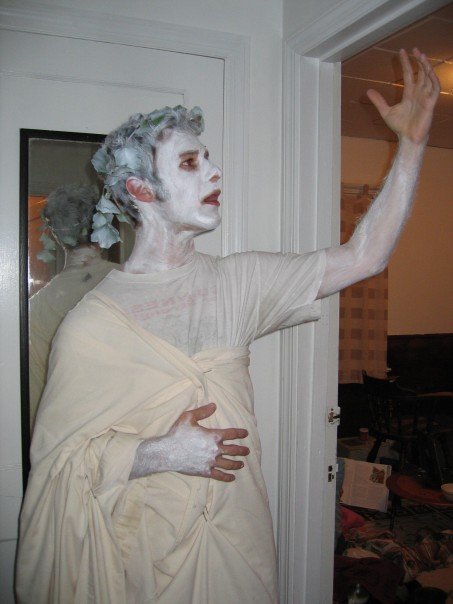In this post, we will introduce the benefits of artistic speech in education. First, however, let’s understand what we mean by artistic speech. All day long we talk, talk, talk, but how often do we pay attention to how we are talking? How much effort do we put into the formation of our vowels and consonants? Unless we are a speech artist (or Jim Carrey), the answer is probably none. We go about our business taking this seemingly mundane activity for granted, like riding a bike or putting on our shoes.
Yet, we are missing something when we do so. As adults who work educationally with children, the way we speak is a potential goldmine if we know how to mine it. Let’s dive into this.
The History of Speaking
The act of artistic speech has been all but forgotten today. Go to a speech training anywhere and you may find a small handful of dedicated speech artists. In fact, such a place as that, a live Eurythmy performance, or (occasionally) a Waldorf classroom may be some of the only places you truly hear speech as art still being practiced. It’s rare.
Yet, it was not always so. Ancient people took language far more seriously than we do today, and there are good reasons for that. The ancient Hebrew people, for example, held their holy words with such regard that some of them could only be uttered and heard by certain individuals. Evidently, it could be harmful to hear such words if you weren’t ready. We may laugh at this today, but I suggest such arrogance may be misinformed. A similar tradition of sanctity has been practiced also in India, among other places. Words have power. Some still do. I’ve experienced it myself, but I’ll leave it at that.
Yet, it wasn’t just what was said but how it was said that mattered. Old tales of wizards and alchemists also hearken to this reality. One had to be careful with words in those ancient days. Yet, I feel it is safe to say that power has largely waned over the epochs. People say whatever they want today without a second thought. Moreover, we don’t seem to care how it sounds, anymore. Think how much stupider English sounds today as compared to Shakespeare’s time. How many of our students try to read something even from 100 years ago and can barely understand it? Yes, our language – both written and spoken – has decayed.
The Formative Power of Artistic Speech
Yet, we can re-enliven our speaking. But, why? Who cares? Well, it matters because artistic speech is beautiful and there are great benefits to our students. This is one of the hidden gems of Waldorf Education that far too few Waldorf teachers even still practice.
In the first grades class I taught back at Asheville Waldorf School, we practiced artistic speech in every lesson. I marveled at how my students loved it. “How can these students enjoy speaking verses and poems so much,” I wondered to myself. I made them speak Ancient Greek and Old Norse, recite tongue twisters with certain movements, and drilled them for weeks on our play lines. I mean, I enjoyed it of course, but I wondered at how I could inspire such nerdiness in others.
Yet, years later it struck me when a colleague of mine mentioned to me how incredibly formed my class was, and she made a connection to the speech work we did. Artistic speech had a formative effect on the children. Practicing artistic speech was akin to practicing calligraphy of the tongue. Think about it. The formation of clear consonants and vowels requires an effort of fine motor skills. Its benefits over time are not unlike those of handwriting, which can also be of benefit to those with ADHD. Try this one for yourself,
“Moses supposes his toesies are roses,
but Moses supposes erroneously.
For, nobody’s toesies are posies of roses
as Moses supposes his toesies to be.”
Try it slow, then fast. Then, say it as if you were a whale, then a chipmunk, then a horse. Try it as many ways as you can think of, and you might get an experience of what I’m talking about.
Artistic Speech for the Re-enlivening of Culture
So, artistic speech can build cognitive well-being in our children, and it can also cultivate in them a sense for beauty in language. That is all good, and we should practice it every day in our lessons.
Yet, this goes further. Why has language decayed over time? It’s because humans have lost the imagination and the art in life. We have become overly hardened and materialistic as a people. Our language has become deadened and mineralized over time because we have. My teachers at the Steiner School of Speech Arts taught me that by re-enlivening our speech with imagination, we help culture become alive again. We re-enlivening the earth!
So, here is your homework. Below is the first stanza of a poem called “Daffodils” by William Wordsworth. Speak those lines outside in the following ways. First, speak them as you normally would. Next, say them again, picturing the image of each line as you say it. Third, see if you can shape the sounds of each letter and word to paint those images for the listener. The sounds are your paintbrushes and paints. Try it, and see what you can come up with.
I wandered lonely as a cloud
That floats on high o’er vales and hills,
When all at once I saw a crowd,
A host, of golden daffodils;
Beside the lake, beneath the trees,
Fluttering and dancing in the breeze.


Leave a Reply
You must be logged in to post a comment.